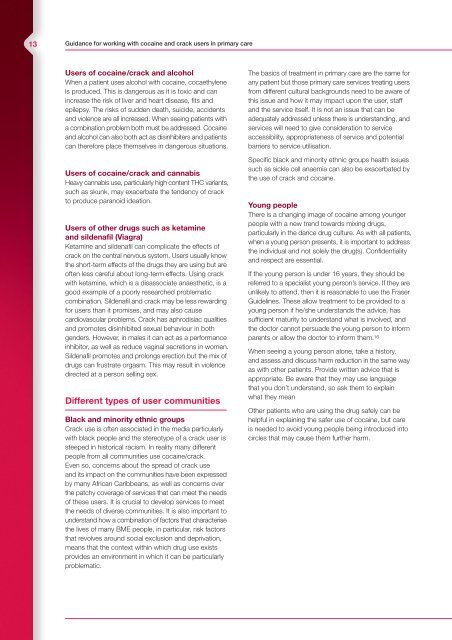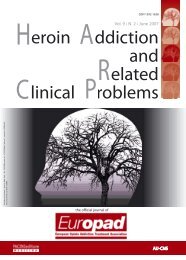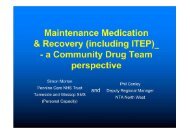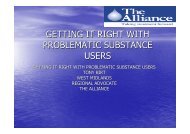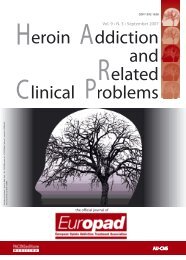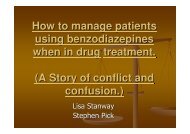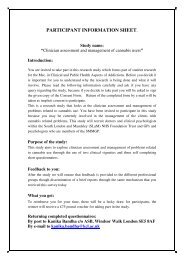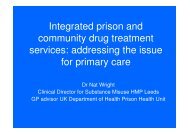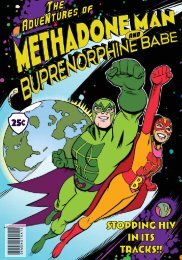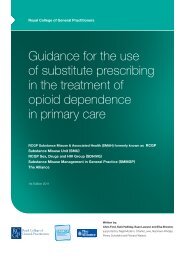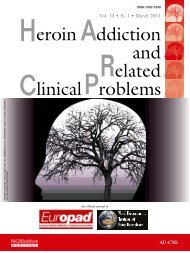cocaine guidance - Royal College of General Practitioners
cocaine guidance - Royal College of General Practitioners
cocaine guidance - Royal College of General Practitioners
- No tags were found...
Create successful ePaper yourself
Turn your PDF publications into a flip-book with our unique Google optimized e-Paper software.
13Guidance for working with <strong>cocaine</strong> and crack users in primary careUsers <strong>of</strong> <strong>cocaine</strong>/crack and alcoholWhen a patient uses alcohol with <strong>cocaine</strong>, cocaethyleneis produced. This is dangerous as it is toxic and canincrease the risk <strong>of</strong> liver and heart disease, fits andepilepsy. The risks <strong>of</strong> sudden death, suicide, accidentsand violence are all increased. When seeing patients witha combination problem both must be addressed. Cocaineand alcohol can also both act as disinhibiters and patientscan therefore place themselves in dangerous situations.Users <strong>of</strong> <strong>cocaine</strong>/crack and cannabisHeavy cannabis use, particularly high content THC variants,such as skunk, may exacerbate the tendency <strong>of</strong> crackto produce paranoid ideation.Users <strong>of</strong> other drugs such as ketamineand sildenafil (Viagra)Ketamine and sildenafil can complicate the effects <strong>of</strong>crack on the central nervous system. Users usually knowthe short-term effects <strong>of</strong> the drugs they are using but are<strong>of</strong>ten less careful about long-term effects. Using crackwith ketamine, which is a disassociate anaesthetic, is agood example <strong>of</strong> a poorly researched problematiccombination. Sildenafil and crack may be less rewardingfor users than it promises, and may also causecardiovascular problems. Crack has aphrodisiac qualitiesand promotes disinhibited sexual behaviour in bothgenders. However, in males it can act as a performanceinhibitor, as well as reduce vaginal secretions in women.Sildenafil promotes and prolongs erection but the mix <strong>of</strong>drugs can frustrate orgasm. This may result in violencedirected at a person selling sex.Different types <strong>of</strong> user communitiesBlack and minority ethnic groupsCrack use is <strong>of</strong>ten associated in the media particularlywith black people and the stereotype <strong>of</strong> a crack user issteeped in historical racism. In reality many differentpeople from all communities use <strong>cocaine</strong>/crack.Even so, concerns about the spread <strong>of</strong> crack useand its impact on the communities have been expressedby many African Caribbeans, as well as concerns overthe patchy coverage <strong>of</strong> services that can meet the needs<strong>of</strong> these users. It is crucial to develop services to meetthe needs <strong>of</strong> diverse communities. It is also important tounderstand how a combination <strong>of</strong> factors that characterisethe lives <strong>of</strong> many BME people, in particular, risk factorsthat revolves around social exclusion and deprivation,means that the context within which drug use existsprovides an environment in which it can be particularlyproblematic.The basics <strong>of</strong> treatment in primary care are the same forany patient but those primary care services treating usersfrom different cultural backgrounds need to be aware <strong>of</strong>this issue and how it may impact upon the user, staffand the service itself. It is not an issue that can beadequately addressed unless there is understanding, andservices will need to give consideration to serviceaccessibility, appropriateness <strong>of</strong> service and potentialbarriers to service utilisation.Specific black and minority ethnic groups health issuessuch as sickle cell anaemia can also be exacerbated bythe use <strong>of</strong> crack and <strong>cocaine</strong>.Young peopleThere is a changing image <strong>of</strong> <strong>cocaine</strong> among youngerpeople with a new trend towards mixing drugs,particularly in the dance drug culture. As with all patients,when a young person presents, it is important to addressthe individual and not solely the drug(s). Confidentialityand respect are essential.If the young person is under 16 years, they should bereferred to a specialist young person’s service. If they areunlikely to attend, then it is reasonable to use the FraserGuidelines. These allow treatment to be provided to ayoung person if he/she understands the advice, hassufficient maturity to understand what is involved, andthe doctor cannot persuade the young person to informparents or allow the doctor to inform them. 16When seeing a young person alone, take a history,and assess and discuss harm reduction in the same wayas with other patients. Provide written advice that isappropriate. Be aware that they may use languagethat you don’t understand, so ask them to explainwhat they meanOther patients who are using the drug safely can behelpful in explaining the safer use <strong>of</strong> <strong>cocaine</strong>, but careis needed to avoid young people being introduced intocircles that may cause them further harm.


